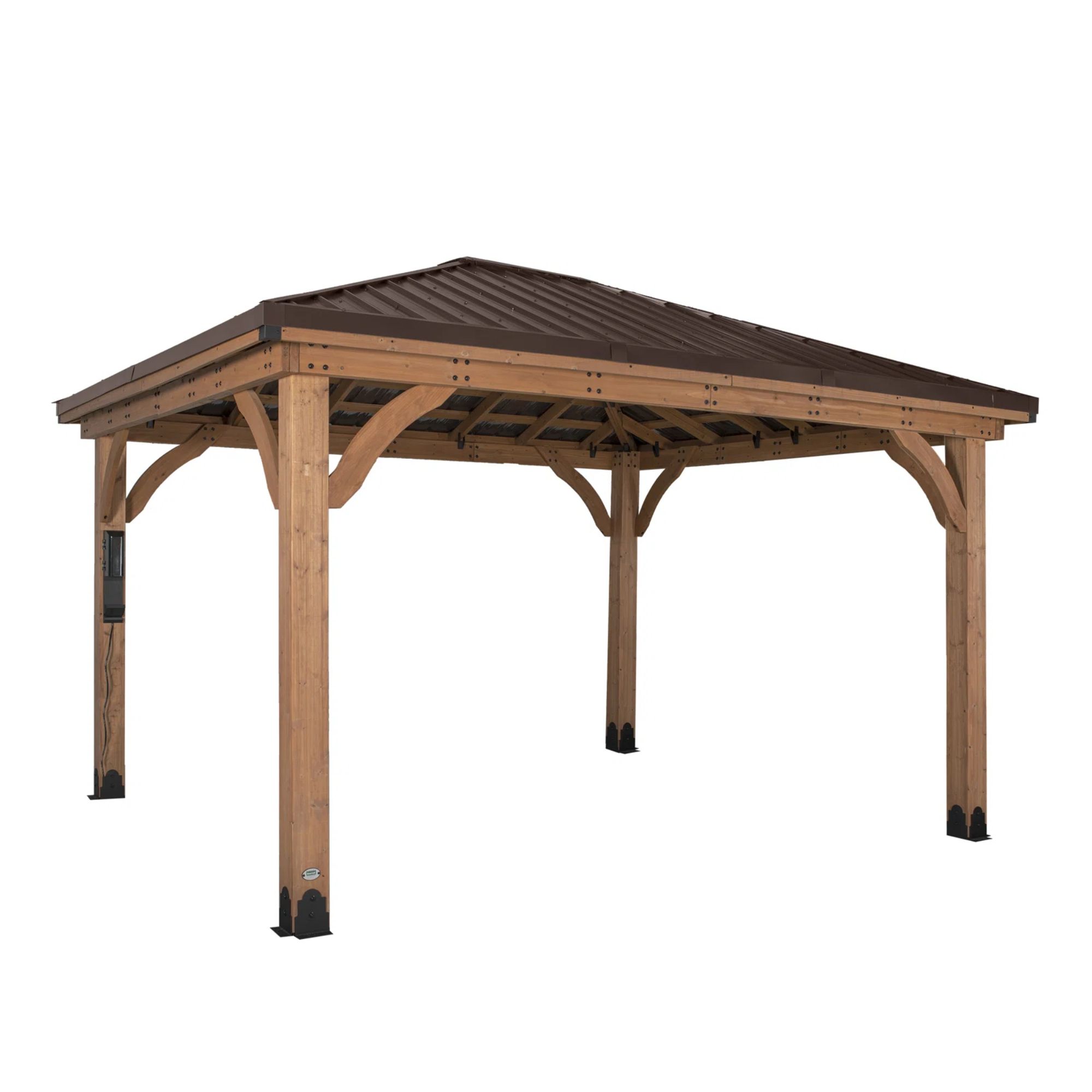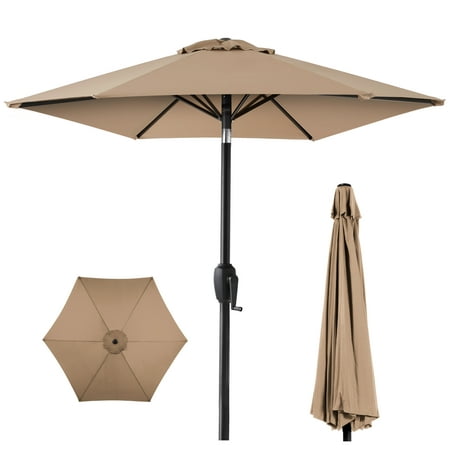Gazebo vs patio umbrella – which is best to beat the heat?
With millions trapped under the heat dome, it's smart to weigh up gazebos vs patio umbrellas to create some much-needed shade


We're in the thick of the summer heat, and if you've spent any time out in the sun you might be wondering how you can cool off. One of the simplest ways to keep cool in summertime is by creating a little shade with a gazebo or a patio umbrella.
However, with personal budgets feeling tight this year, not all of us can afford both of these solutions.
I spoke to gardening experts about the benefits and drawbacks of both types of outdoor furniture to help you decide which is best for your yard.
What are the benefits of a gazebo?

There are two types of gazebo, and the two types have different benefits. The first type is a permanent gazebo. These structures usually have to be built by contractors and are a permanent addition to your yard. Permanent gazebos often add value to your home, so they can be a smart investment if you plan to sell your home. Many large permanent gazebos also have outlets installed, so make a great place to listen to music, or plug in a television to watch movies and sports.
Impermanent gazebos are usually made from lightweight aluminum frames and polyester curtains. The best thing about these structures is that they're cheap, so unlike a permanent structure, you don't need to spend thousands of dollars. They're simple to put together, and you can do it yourself. You can also take them down for storage in the winter months when you probably won't be using your yard.
Content editor at H&G and gardener, Drew Swainston, told me that 'Both types of gazebo offer shade in parts of the yard that may not get any shade from trees or buildings. If you install curtains, they also offer relief from bug bites as well as a little privacy.'

Drew qualified as a journalist and wrote for many websites and publications, before studying for a horticulture qualification. He worked as a professional gardener for several years, specializing in kitchen gardening. He's now bringing his expertise and passion to Homes & Gardens as a member of our team.

Seats: 4 Dimensions: 10ft x 10ft x 9.30ft Materials: iron, polyester
This gazebo is perfect for hotter climates. The usual heavy curtains are supplemented with light, airy netting that will keep you cool and protected from bug bites without closing off the entire gazebo.

Seats: 8 Dimensions: 14ft x 10ft x 9ft Materials: cedar, steel
This gazebo is a classic wooden design that will work for most gardens. However, the best feature is hidden at the back. This gazebo has a power outlet built-in, so you can run electric grills, speakers, TVs, and projectors in the great outdoors.

Seats: 6 Dimensions: 12ft x 12ft x 9ft Materials: cedar, pine
If you want a permanent structure, I like this octagonal design. Made by Amish craftsmen in the USA, this traditional gazebo is built to last. It's perfect for a quiet area at the bottom of the yard, away from the noise of the house and the street.
What are the drawbacks of a gazebo?

Installing a gazebo can be very inconvenient. Permanent structures need a building permit, and if you aren't comfortable with DIY, you'll have to hire a team to build your structure, too.
Design expertise in your inbox – from inspiring decorating ideas and beautiful celebrity homes to practical gardening advice and shopping round-ups.
Of course, hiring labor to build a gazebo can be pretty pricey, and what's more, the structure itself can be very expensive too. All in all, you could be looking at spending thousands of dollars on some shade.
You'd think it would be easier with impermanent gazebos, but these can also be convoluted to slot together and build. These gazebos also have the issue of storage. They're usually constructed from 10ft poles and large amounts of polyester fabric, which can be tricky to store in winter when you aren't using your gazebo.
Gazebos also take up a lot of room. A 10ft by 10ft square is a lot of real estate to give up in a yard, and it can impact how you and your family use the space. A gazebo could stop you and your kids playing catch, or ruin the sight lines from your deck over the rest of the yard.
These structures also aren't easily adjustable. A patio umbrella can turn to face the sun and provide reliable shade. A gazebo is stuck in one place, so you may find that the full sun shines straight into your gazebo when it's low in the sky in the early morning or late evening.
What are the benefits of a patio umbrella?

The biggest benefit of a patio umbrella is that it's much cheaper than both types of gazebo. With a little research, you can easily find a good patio for under $100, which is hundreds - if not thousands- of dollars cheaper than a gazebo.
Patio umbrellas are also pretty mobile. Patio umbrellas fold up, and they're so lightweight that you can easily move them around the garden. If you want some shade while you eat, you can put the umbrella by your outdoor table, and if you decide to swim later, you can put it next to the chaise longue by your pool.
Head of Gardens at H&G, and gardening expert, Rachel Bull told me that 'A large umbrella shade is a mainstay of my backyard patio. What I love about it is I can move or tilt the shade as the day goes on and the sun gets higher in the sky, so whether I’m working outside or entertaining friends, I don’t have to worry about moving during the day.'
This means a patio umbrella is more effective at creating shade. As the sun moves across the sky, you can easily adjust your umbrella to ensure you're always in the shade. You can't do this with a gazebo.

Rachel is a gardening writer, flower grower and floral designer. Her journalism career began on Country Living magazine, sparking a love of container gardening and wild planting. After more than a decade writing for and editing a range of consumer, business and special interest titles, Rachel became editor of floral art magazine The Flower Arranger. She then trained and worked as a floral designer and stylist in London for six years, joining the H&G team in 2023.

This large patio umbrella is cantilevered, so you won't have to peer around an annoying umbrella stand in the middle of the conversation. The base is included, and it has solar-powered LEDs underneath to light up your furniture when parties run late into the night.
What are the drawbacks of a patio umbrella?

The drawback of a patio umbrella is that you can't always use it for shelter. Patio umbrellas are poor in storms. For example, almost every gazebo can handle rain, but not every patio umbrella is waterproof. While they can cover a large area with shade, they don't cover the same amount of ground, so if you're caught in a sudden rainstorm, you might be soaked. Even if you aren't soaked, some wooden patio umbrellas are poor at handling water, and can easily warp and crack from exposure to moisture. They're also less sunproof than most gazebos, which tend to have metal roofs. Though it's less of a problem with white patio umbrellas, colorful designs can easily fade in full sun.
While umbrellas can be moved around the garden to provide shade, they don't always provide that much shade. Rachel told me 'While I love the look of the tasseled boho parasols like this on Amazon, these are much smaller and wouldn’t give me as much coverage on hotter days. Still, I’m planning to add one to a smaller dining area on our patio this summer, for a stylish accent for when it’s not super hot.'
While they're often cheap, high-end cantilevered umbrellas can be incredibly expensive. Gazebos are almost always more expensive, but I've seen patio umbrellas listed for as much as $10,000. Unlike a gazebo, an impermanent accessory like a patio umbrella won't do anything to the value of your home.
Patio umbrella FAQs
Can you replace patio umbrella fabric?
Yes, you can replace patio umbrella fabric. You'll have to measure your old fabric to find a suitable replacement, but there are lots of options on big retailers like Amazon and Wayfair.
What is the best fabric for a patio umbrella?
The best fabric for a patio umbrella is UV-resistant, waterproof polyester. The best color for an outdoor umbrella is white because it keeps you cool. The only drawback with this color is that it shows up moss and weather stains more easily.
For more help with outdoor furniture, take a look at our advice on how to clean a patio umbrella, or ideas for lighting a gazebo.

As a gardens and lifestyle contributor, Alex makes sure readers find the right information to help them make the best purchase. Alex got his start in reviewing at the iconic Good Housekeeping Institute, testing a wide range of household products and appliances. He then moved to BBC Gardeners’ World Magazine, assessing gardening tools, machinery, and wildlife products.

